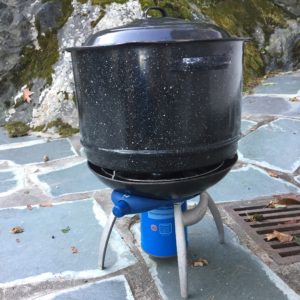It is time. Time to stop reading, planting, nurturing and foraging. It’s time to start my journey into natural dyes. My first bite into this aromatic and interesting exploration is to make a mordant from rhubarb leaves.
“What is a mordant,” you ask?
The water based, delightful tonic binds the color to the fiber – chemistry in action. A mordant’s role in dyeing fiber is particularly important as natural dyes tend to fade. If I spend my time on an art quilt, longevity and conservation are paramount. I’ll do what I can to ensure this piece will be around for a long while.
As in many journeys, where would we be without our support network? Thanks to a dear friend who shared 1.5kg of gorgeous rhubarb leaves (and even stalks to eat!).

My young rhubarb plant doesn’t have nearly as many beautiful leaves, so I’m grateful for this contribution.
With an enamel pot found at a Savers, my “elixir” topped my camping stove on Saturday night. It’s not exactly singalong or s’more style, but the desired results were attained (or at least, I hope so… wait and see the final results). After simmering for several hours and sitting in the bath all night, I hope this mordant will do the trick.

I’m gathering pokeberries and putting them in the freezer to create a dye bath that hopefully will not be too fugitive… using a recipe from Chris MacLaughlin’s A Garden to Dye For: How to Use Plant from the Garden to Create Natural Colors for Fabrics and Fiber.
Next up? Picking up acorns before the squirrels get them all! Wish me merry mordant making.




